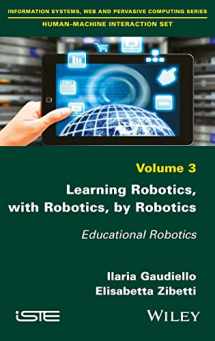
Learning Robotics, with Robotics, by Robotics: Educational Robotics (Information Systems, Web and Pervasive Computing: Human-machine Interaction Set)
Book details
Summary
Description
The relationship between technological and pedagogical innovation has recently created a new field of research at the crossroads between Psychology, Educational Sciences and Artificial Intelligence: Educational Robotics (ER).
Through analysis of the achievable educational goals based on the technological status and specific learning modes of different types of robots, it is possible to define three pedagogical paradigms: learning robotics, learning with robotics, and learning by robotics.
In this book we address these three paradigms through three themes: human representations of robots, the acceptance and trust shown when interacting with a humanoid, and learning favored by the development and programming of robots in an educational context. These themes allow the authors to fully explore, define and delimit this novel field of research for future application in educational and social contexts.
Finally, the book discusses contributions and limitations which have emerged from different methodologies of research, potential educational applications, and concepts of human–robot interaction for the development of the above paradigms.


We would LOVE it if you could help us and other readers by reviewing the book
Book review



